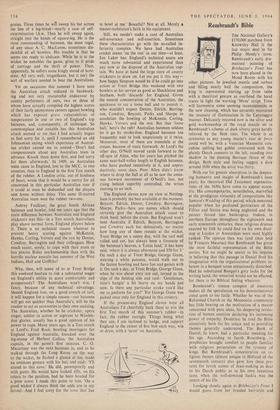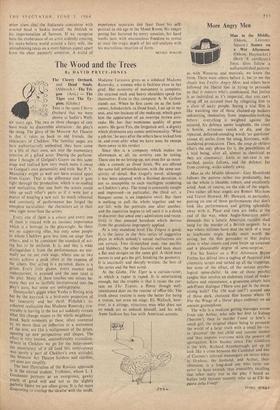Rembrandt's Bible
THE National Gallery's £170,000 purchase from Knowsley Hall is the last major deal in Sir Philip Hendy's term. Rembrandt's early dra- matised painting of nBelshazzar's Feast has been placed in the Mond Room with his other pictures. In jewelled mantle and turban and filling nearly half the composition, the king is represented starting up from table with a theatrical gesture as overhead the hand traces in light the warning `Mene' script. Time will harmonise some seeming inconsistencies in the new cleaning, which has certainly recovered the intensity of illumination in the Caravaggio manner. Delicately restored now is the silver and gold workmanship of the royal mantle set in Rembrandt's scheme of dark silvery greys hardly relieved by the flesh tints. The whole is as strenuous as any young master's tour de force could well be, with a Venetian Mannerist con- cubine spilling her goblet contrasted with the plainly Dutch consorts to the left, receding into shadow in the slanting Baroque thrust of the design. Both style and feeling suggest a date around 1636 when the artist was thirty.
With our far greater absorption in the deepen-. ing humanity and insight of Rembrandt's later years, his rhetorical Old Testament representa- tions of the 1630s have come to appear eccen- tric. His contempotaries, nevertheless, marvelled at the prodigious virtuosity of compositions like Samson's Wedding of this period, which remained popular when his profound portraiture of the Fifties and Sixties, was being neglected and the painter forced into bankruptcy. Indeed, in northern Europe throughout the eighteenth and early nineteenth centuries, these religious dramas enacted by folk he could find on his own door- step at Leyden or Amsterdam were most highly ranked. The opinion then was (and since held by Francois Mauriac) that Rembrandt has given the most faithful representation of the Bible stories. Yet we might be nearer to his impulse in believing that this passage in Daniel fired his imagination with the organisational problems in- herent in a banquet scene sensationally disturbed. Had he substituted Banquo's gory locks for the writing hand, the sensation would not be affected, for there is no Biblical feeling whatever.
Rembrandt's intense complex of emotions makes all the speculation on his denominational creed seem to me futile. Whether he was of the Reformed Church or the Mennonite community has little bearing on the motivation of a master concerned with pure ideas, his deepening revela- tion of human emotion declaring his increasing power of empathy. Doubtless he read the Bible attentively both for his solace and as providing themes generally understood. The Book of Daniel, he knew, had a particular meaning for his age. According to Jacob Rosenberg, its prophecies brought comfort to people familiar with religious persecution or the tyranny of kings. But Rembrandt's concentration on re- ligious themes (almost unique in Holland of the seventeenth century) also gave him these pre- texts for lavish scenes of feast-making as dear to his Dutch public as to his own luxurious taste, when the well-dowered Saskia was the centre of his life.
Lookjng closely again at Belshazzar's Feast I would guess from her braided hair-style and
other clues that the ltalianate concubine with averted head is Saskia herself, the Delilah to his impersonation of Samson. If we recognise here the exuberance of an artist ardently creating his make-believe world around a fairy wife, the attitudinising takes on a more human aspect apart from the sheer painterly ambition. A world of
experience separates this feast from his self- portrait in old age in the Mond Room. No longer posing but battered by every emotion, his hand works here with unconscious freedom to reveal at once the tragic depth of his self-analysis with his marvellous intuition of form.
NEVILE WALLIS







































 Previous page
Previous page